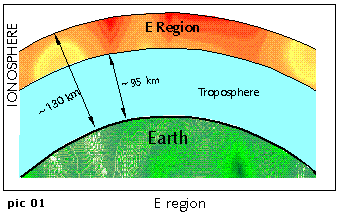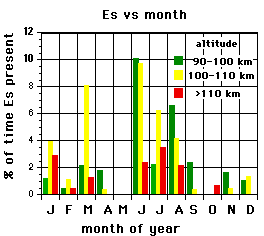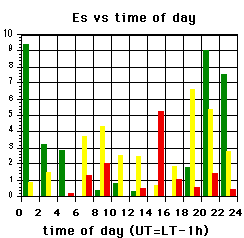| . | |||||||
Irregular scattered patches of relatively dense ionization that develop seasonally within the E region (pic 01) and that reflect and scatter frequencies up to 150 MHz.
Note 1: The sporadic E is a regular daytime
occurrence over the equatorial regions and is common
in the temperate latitudes in late spring, early summer and, to a lesser
degree, in early winter.
In the E region, that is medium on the 100 km of quota,
they are formed every so often, species in the months that
go from May to October, of the Ionian heaps of and electrons,
in which NOT +prevail, Or+ and nuclei of Fe
and Mg that raise a lot the density of onizzazione in limited
areas. From the point of view of the propagation,
this complex phenomenon of the high atmosphere produces
an elevation of the maximum frequency
that can endure reflection. The increase is always considerable:
while the E layer normal school, to the summery midday, in the moments
of greater ionization Mhz can have a m.u.f. for 15/20 shaving beam of,
the Es is of rule in a position to
sending back to Earth beacons to the frequencies
of 30/80MHz. In particular cases, whose percentage
decreases to growing of the frequency, the density is
such to interest the beacons of 80, 100
and also 200MHz, This last frequency seems to be the limit: but
in 1% of the cases, regarding the 30MHz, the communications in range 2
meters through Es can happen. The Es openings in two meters
are therefore insufficient, but therefore rare like it would not be capacities
to think: since, usually, they are of short duration, and however the
reflection area is narrow to a zone from 50 to 100 Kmq, the stations that
can avvalersi of the phenomenon, in the range two meters, they would not
have to trovarsi not more than 1000Km from the area of reflections (or
point of scatter) and can communicate with other placed stations to similar
distances and single in determined directions. It would seem also that
the formation of such phenomenon is concentrated over an area of low pressure,
comprised between two cold fronts; that is over a cyclonic area, faced
from a cold front. Usually such phenomenon happens with greater frequency
between April to October with its maximum (duration, stability and m.u.f.)
between high May and August. Usually the better timetables are those from
the eight to the 19 (that is of day) can in any case happen such phenomenon
also after the 20 and that often coincides with the more interesting openings,
in other words the distance between the correspondents is greater that
not during the day. References: - Dyson, P. L., and J. A. Bennett, "A model of the
electron concentration in the ionosphere and its application to oblique
propagation studies", J. Atmos. Terr. Phys., 50, 251-262,
1988. |
|||||||
| |
|||||||
| |
|||||||
| |
|||||||
| |
|||||||
|
Last
modified: |
|||||||



